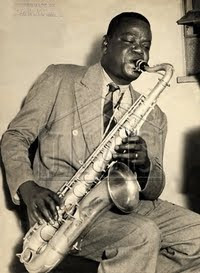Vibrações Brasileiras
Woodwind instruments have been standard instruments in choro since the beginning. The flute was the lead melody instrument of the terno, the original (trio) choro ensemble consisting of flute, cavaquinho and guitar, while larger ensembles like the bands led by Anacleto de Medeiros also excelling in early choro were based on brass instruments. Pixinguinha started as a flutist, but already after his visit to Paris in 1922 with his Oito Batutas, he fell in love with the tenor saxophone, but was prevented from playing the instrument in public until much later, mainly because of national critics claiming the saxophone to spoil Brazilian music by Americanized jazzinfluence. The saxophone was early on perceived as an American jazz-instrument, although the origins of it was French and in Europe was considered a respectable member of the woodwind ensemble of a symphony or militaire orchestra. However, gradually the saxophone was heard as a melody lead voice in choro despite public animosity, pioneers of the
instruments in choro like Pixinguinha, Luiz Americano, Severino Rangel (Ratinho), Severino Araúja and Abel Ferraira brought the saxophone to prominence in Brazil, and Ratinho's classic, 'Saxofone, por que choras?', soon became a part of the standard repertoire of any choro ensemble. - The choro revival in Brazil from the 1970s and on
continued to showcasting the saxophone as a respectable choro instrument, and in later years a renewed interest of the history of the instrument in choro has been established through various projects and important recordings like i.e. the cds 'Choros, por que sax?' by Mario Sève and Daniela Spielmann and 'Brasileiro Saxofone' by Nailor Proveta. A recently released cd by sax-player Flavio Sandoval, 'Vibrações Brasileiras' (Tratore, 2012), continues the focus on the saxophone as a lead voice in a repertoire of choro compositions.
Flavio Sandoval is a multi-instrument-player from São Paulo, who turned professional at 15. His main instruments are saxophone, flute and violão, and besides being a musician he also does research and gives lectures on Brazilian music tradition. He has recorded three cds before the shown 'Vibrações Brasileiras', and he tours every year both in Brazil and Europe, where he often plays together with Nelson Latif in a duo named 'Dois no Choro'. On the new cd Flavio Sandoval is accompanied by Mauricio Marques on piano, Edimilson Capelupi on violão 7 cordas and Alexandre Biondi on percussion and vibraphone. Flavio plays both tenor and soprano saxophone, and several tracks on the cd have over-dub of the lead instrument to enrich the impression of a multi-voiced ensemble. - The repertoire of the disc is concerned with classic choros like 'Murmurando', 'Aguenta Seu Fulgêncio', 'Atlantico', a selction of Jacob do Bandolim titles like 'Assanhado', 'Diabinho Maluco', 'Vibrações' and 'Sapeca', further some tip-of-the-hat to other Brazilian saxophonists like 'Modulando' and 'Haroldo No Choro' - in all, 13 tracks exposing the saxophone as lead voice in an excellently produced recording. - The cd is available for download as mp3-files from Amazon, and more info about Flavio Sandoval is to be found at his official website (both in Portugues and English), click here
You can watch several uploaded videos featuring Flavio Sandoval at his website, here is an example from YouTube recorded last year at a live performance. Sandoval plays soprando sax and is accompanied by Edimilson Capelupi on violão 7 cordas and Alexandre Biondi on pandeiro - enjoy!
---
Jo
Flavio Sandoval is a multi-instrument-player from São Paulo, who turned professional at 15. His main instruments are saxophone, flute and violão, and besides being a musician he also does research and gives lectures on Brazilian music tradition. He has recorded three cds before the shown 'Vibrações Brasileiras', and he tours every year both in Brazil and Europe, where he often plays together with Nelson Latif in a duo named 'Dois no Choro'. On the new cd Flavio Sandoval is accompanied by Mauricio Marques on piano, Edimilson Capelupi on violão 7 cordas and Alexandre Biondi on percussion and vibraphone. Flavio plays both tenor and soprano saxophone, and several tracks on the cd have over-dub of the lead instrument to enrich the impression of a multi-voiced ensemble. - The repertoire of the disc is concerned with classic choros like 'Murmurando', 'Aguenta Seu Fulgêncio', 'Atlantico', a selction of Jacob do Bandolim titles like 'Assanhado', 'Diabinho Maluco', 'Vibrações' and 'Sapeca', further some tip-of-the-hat to other Brazilian saxophonists like 'Modulando' and 'Haroldo No Choro' - in all, 13 tracks exposing the saxophone as lead voice in an excellently produced recording. - The cd is available for download as mp3-files from Amazon, and more info about Flavio Sandoval is to be found at his official website (both in Portugues and English), click here
You can watch several uploaded videos featuring Flavio Sandoval at his website, here is an example from YouTube recorded last year at a live performance. Sandoval plays soprando sax and is accompanied by Edimilson Capelupi on violão 7 cordas and Alexandre Biondi on pandeiro - enjoy!
---
Jo






2 Comments:
Thanks Jo for spotlight the saxophone and this great album in the Choro blog
Hans
Hey, are you from brazil?
its just fantastic that some people from other countries like such an old and different kind of music like choro. im brazilian and i know almost nothing about it, but anyway I still get amused to see that people like brazil not only because of the shit that media says about here.
Nice blog :)
keep up the good work.
Post a Comment
<< Home